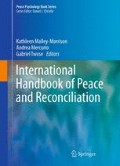Abstract
This chapter presents a brief history of China, Japan, and Korea with an emphasis on peace and reconciliation. This is followed by a discussion of definitions of peace and reconciliation from participants from these regions to the Personal and Institutional Rights to Aggression and Peace Survey. The most common type (49 %) of definition of peace focused on the prerequisites and outcomes of positive peace (a peace characterized by social justice and equality), whereas 38 % of the responses focused on negative peace (e.g., absence of war, conflict). Sixty-five percent of the definitions of reconciliation equated it with a process rather than an end state or achievement. Exploratory chi-square analyses for types of definitions revealed a few differences based on demographic characteristics such as gender, military service, having a relative in the military, and having participated in antiwar protest activity.
Access this chapter
Tax calculation will be finalised at checkout
Purchases are for personal use only
References
(No author) Korean war– 1950–1953. (n.d.). Retrieved from http://www.globalsecurity.org/military/ops/korea.htm
(No author). China’s initiation of the five principles of co-existence. (2000). Retrieved January 22, 2012, from http://www.fmprc.gov.cn/eng/ziliao/3602/3604/t18053.htm
Akbar, A. (2010). Mao’s great leap forward ‘killed 45 million in four years.’ The Independent. Retrieved December 2, 2011, from http://www.independent.co.uk/arts-entertainment/books/news/maos-great-leap-forward-killed-45-million-in-four-years-2081630.html
Amnesty International Annual Report: Japan 2011. (2011). http://www.amnestyusa.org./research/reports/annual-report-japan-2011
Associated Press. (2012). North Korea: New leader credited with commanding nuclear tests.
Bi, J. (2005). China’s new concept for development. In China in a globalizing world (pp. 105–124). New York/Geneva: United Nations.
Cho, S.-R. (2010). The quest for an effective Korean strategy. In T.-H. Kwah & S.-H. Joo (Eds.), Peace regime building on the Korean peninsula and Northeast Asian security cooperation. Burlington, VT: Ashgate.
Dean, M. (2008). Sold in Japan: Human trafficking for sexual exploitation. Japanese Studies, 28(2), 165–178.
Evans, M. L., & Richelson, J. T. (1999). Tiananmen square, 1989: The declassified history. Retrieved November 30, 2011, from http://www.gwu.edu/∼nsarchiv/NSAEBB/NSAEBB16/
Glaser, B. G., & Strauss, A. L. (2007). The discovery of grounded theory: Strategies for qualitative research. Chicago: Aldine.
Harms. W. (1996) China’s great leap forward. The University of Chicago Chronicle. Retrieved from http://chronicle.uchicago.edu/960314/china.shtml
Henshall, K. (1999). A history of Japan from stone age to superpower. New York: St. Martin’s Press.
Hirofumi, H. (2001). Structure of Japanese imperial government involved in military comfort women system. Paper presented at international conference on Japanese crimes against humanity: Sexual slavery and forced labor. Available at http://www32.ocn.ne.jp/∼modernh/eng09.htm
Human Rights Watch (2000). Owed justice: Thai women trafficked into debt bondage in Japan. Retrieved from http://www.hrw.org/legacy/reports/2000/japan/
Jeans, R. B. (2005). Victims or victimizers? Museums, textbooks, and the war debate in contemporary Japan. Journal of Military History, 69(1), 149–95.
Kab-Woo, K. (2006). The system of division on the Korean peninsula and building a ‘peace state. Korea Journal, 46(3), 11–48.
Kingston, J. (2007). Awkward talisman: War memory, reconciliation and Yasukuni. East Asia: An International Quarterly, 24(3), 295–318.
Kushner, B. (2007). Nationality and nostalgia: The manipulation of memory in Japan, Taiwan, and China since 1990. The International History Review, 79(4), 793–820.
Malley-Morrison, K., Daskalopoulos, M, & You, H-S. (2006 winter) International perspectives on governmental aggression. International Psychology Reporter, 19–20.
Min, P. G. (2003). Korean “comfort women.” The intersection of colonial power, gender and class. Gender and Society, 17(6), 938–957.
Oh, D., Murata, A., Kim, H. M.-S., Murata, M., & Jones-Rooy, A. (2012). East Asia. In K. Malley-Morrison, D. A. Hines, & S. McCarthy (Eds.), International handbook on war, torture, and terrorism. New York: Springer.
Pan, E. (2006). The promise and pitfalls of China’s ‘peaceful rise.’ Council on foreign relations. Retrieved from http://www.cfr.org/china/promise-pitfalls-chinas-peaceful-rise/p10446
Park, Y. (2000). The 2000 South–north summit: A historic overture to peaceful coexistence. Korea and World Affairs, 24(2), 193–206.
Polaris Project. (2010) Polaris Project: For a world without slavery. Accessed from http://www.polarisproject.org/content/view/58-78
Reischauer, E. O. (1964). Japan past and present. New York: Alfred A. Knopf.
Soh, C. S. (2003). Japan’s national/Asian women’s fund for “comfort women”. Pacific Affairs, 76(2), 209–233.
Sutter, R. (2004). Asia in the balance: America and China’s ‘peaceful rise. Current History, 103(674), 284–289.
The Seattle Times. (2001). Sex-slave guilt far-reaching in Japan, research says.
Tuman, J. P., Strand, J. R., & Emmert, C. F. (2009). The disbursement pattern of Japanese foreign aid: A reappraisal. Journal of East Asian Studies, 9(2), 219–248.
United States Department of State. (2010). 2009 Human rights report: Japan. Bureau of Democracy, Human Rights, and Labor. Washington, DC. Accessed from http://www.state.gov/g/dri/rls/hrrpt/2009/cap/135993.htm
Whiting, A. (1988). China eyes Japan. Berkeley, CA: University of California Press.
Yamazaki, J. W. (2005). Japanese apologies for World War II: A rhetorical study. London: Routledge.
Author information
Authors and Affiliations
Corresponding author
Editor information
Editors and Affiliations
Additional information
We want to thank Michael Weinberg, Librarian and Laurie Chapkin, Graduate Assistant at Northeastern Illinois University for their assistance with the literature search.
Rights and permissions
Copyright information
© 2013 Springer Science+Business Media New York
About this chapter
Cite this chapter
Murata, A., Murata, M., Shahane, A., Jones-Rooy, A., Kim, H.MS. (2013). Definition of Peace and Reconciliation in China, Japan, and Korea. In: Malley-Morrison, K., Mercurio, A., Twose, G. (eds) International Handbook of Peace and Reconciliation. Peace Psychology Book Series, vol 7. Springer, New York, NY. https://doi.org/10.1007/978-1-4614-5933-0_10
Download citation
DOI: https://doi.org/10.1007/978-1-4614-5933-0_10
Published:
Publisher Name: Springer, New York, NY
Print ISBN: 978-1-4614-5932-3
Online ISBN: 978-1-4614-5933-0
eBook Packages: Behavioral ScienceBehavioral Science and Psychology (R0)

